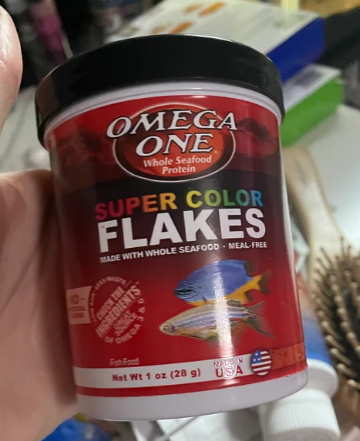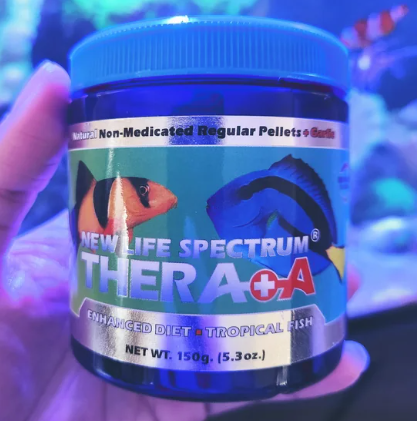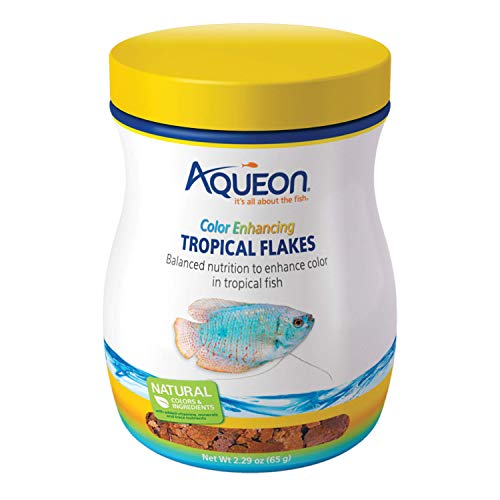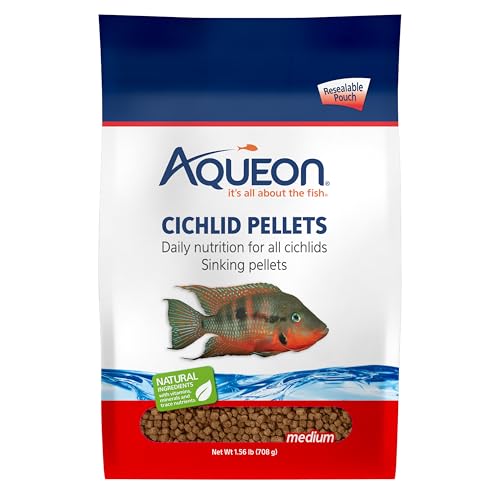Clean water, optimum space, and proper nutrition are the basic elements required to maintain a healthy aquarium. As your aquatic friends are incapable of collecting and choosing their food, you’re the one responsible for their balanced and enriched diet.
Stuck in between the argument of formula food and live food, we often overlook the most critical aspects of the discussion: preference and proper growth of your aquatic friends. Irrespective of the food type and brand you may choose, it should be suitable for the “diners” regarding taste and development.
In this article, we’ll go through the most common types of fish food, including flakes, pellets, and live food, to articulate their nutritional contributions, benefits, and, most importantly—drawbacks.
Table of Contents
Types of Fish Food
Several types of food with nutritional elements in different proportions are available in the market for your fish. Many of them categorize themselves by species, and others present themselves as a generalized solution for freshwater or saltwater aquariums.
Beginner aquarists often fail to ensure the proper nutrition required for their fish and feed either whatever comes up frequently on Amazon or whatever their fish likes the most. For those who belong to these groups, we’ve discussed what kind of food is best for your fish in this section.
Flake Food

Flake foods are probably the most convenient and popular choice among beginners, with smaller fish and even smaller aquariums. Flake choices often include a variety of ingredients, including fish meal, shrimp meal, algae, vitamins, and minerals. They’re processed and compressed into thin sheets to be crushed for easier consumption.
Most flake foods are floating in nature and are designed to delay submersion for easier pecking by smaller fish species. This characteristic of flake food makes it well-suited for fish that prefer to feed from the upper water column. However, it also makes the flakes all the more challenging for community aquariums with bottom-dwellers and pelagic fish (midwater).
Flake foods made for specific fish species are often manufactured with colors and artificial flavoring to make them more appealing for the fish and trigger their natural feeding instincts. This can encourage a more enthusiastic feeding response.
Composition and Nutrition
Let’s discuss the benefits of having particular nutritional elements in your preferred fish food.
- Fish Meal
Fish meal is often the primary protein and fat source of flake foods. It’s derived from processed fish and provides the necessary amino acids responsible for growth and health. It contributes to overall muscle development, metabolic process, and immune system.
- Shrimp Meal
Shrimp meal has different amino acid profiles than fish meal and, therefore, is necessary to be added as an additional source of protein in flake foods. Furthermore, shrimp meal emulates their natural feeding patterns more closely—making it more palatable.
- Algae and Plant Matter
Omnivorous fish species require fibers, plant protein, and essential vitamins found in algae and plant matter to thrive. Plant matter also ensures proper digestion and contributes to a more balanced diet for smaller fish species that rely on plankton for survival.
- Vitamins and Minerals
Added vitamins and minerals strengthen your fish’s immune system, reduce the risk of diseases, and promote bone development. As most fish are unable to synthesize vitamins, it’s necessary to supplement their diet with essential minerals and vitamins.
- Carbohydrates
Carbohydrates are a secondary source of energy for fish. Although carbohydrates aren’t as digestible to fish as protein and fat, they are included in commercial fish flakes to keep production costs down. While it may not harm your fish, it’s hardly an essential component.
- Stabilizers and Binders
Stabilizers and binders are added during the production process to maintain the structural integrity of the flakes. These components typically don’t contribute to the nutritional equation but prevent the flakes from breaking down into undesirable powder.
- Color Enhancers
Depending on the fish species and their color profile, you may find beta-carotene, astaxanthin, canthaxanthin, and spirulina in the fish flakes. These are considered color enhancers for vibrant fish species such as guppies, koi, and certain cichlids.
Suitable Fish Species
Flakes are convenient food sources. But don’t forget to offer your fish a varied diet of live/frozen food and algae wafers for a more balanced nutrition. Here are a few fish species that primarily enjoy flake foods, although the list isn’t exhaustive.
- Guppies
These small species of colorful freshwater fish readily accept flakes and thrive on products containing a higher amount of protein and fat.
Best flakes for guppies: Tetra TetraMin Plus Tropical Flakes
- Mollies
Mollies require a comparatively higher amount of plant matter to maintain their metabolic functions. Depending on the species, they may also benefit from additional color enhancers.
Best flakes for mollies: Aqueon Tropical Flakes Color Enhancing
- Bettas
Bettas are typically known for their carnivorous tendencies; they can also benefit from occasional flake food enriched with fish protein and plant matter.
Best flakes for bettas: Ultra Fresh Betta Fish Food
In addition, mid-water feeders like tetras, barbs, and danios, and bottom feeders like plecos and loaches mostly benefit from sinking flakes.
Drawbacks of Flake Food
The benefits of flake food include convenient feeding, easier digestion, and pricing. The drawbacks of the same are:
- Flakes easily spoil the water
Flake foods easily disintegrate and sink to the bottom after a few minutes of water absorption. Subsequently, it spoils and rapidly jeopardizes the water quality by introducing organic debris and increasing chlorine levels.
- Limited sinking options
Flakes are mostly considered for surface feeders and are not suitable for community tanks. They lack the sinking options (slow-sinking, sinking, floating) appropriate for different fish species.
- Have lower nutritional values
Flake foods have a higher amount of fillers and binders, reducing the nutritional concentration.
- Overfeeding risk
It’s tough to estimate the portion size of the lightweight flakes after they’ve absorbed the water. Inexperienced aquarists may overfeed their fish with flake foods.
- Flakes are quite fragile
Flakes often get obliterated during shipping and arrive in unusable powder form. While you may try to feed the granules to your smaller fish, they often get ignored and wasted.
Pellet Food

Pellets are densely packed nutritional food sources for fish, formed in small capsules or pellets to make it easier for larger fish to gobble them. To suit a variety of fish species, from small to large, pellets come in different sizes and shapes. However, pellets are typically designed for comparatively larger fish species like koi, large cichlids, discus, etc.
Similar to flake foods, pellets also consist of fish meal, shrimp meal, soybean meal, and vitamins, but pellets often have a higher concentration of these ingredients and offer a more balanced diet. The uniform size of pellets also promotes better portion control and a similar balance of nutrition.
Dispensing pellets is also easier. Due to its shape and better structural integrity, you don’t need to continuously wonder if the automatic dispenser is reliably working or not. In our professional opinion, high-quality pellets, supplemented by live/frozen food, should be the first choice as fish food unless there is a necessity.
Pellets Vs. Flakes
I used to wonder why flakes exist if we have pellets and vice versa. But, after a few years of fishkeeping, here’s what I could gather.
- Shelf life
Pellets have a much higher shelf life than flakes. Flakes, with more surface area and hydrophilic characteristics, can’t be stored safely for an extended period.
- Variety of formulas
The production process of pellets is much more controlled and customizable. You can find pellets for almost every kind of tropical and saltwater fish species. The nutrition density of pellets is also much higher than that of flakes.
- Digestibility
Pellets often are infused with enzymes and probiotics for better digestibility. Some high-quality pellets also include vitamin C to promote a better immune system and overall physiological functions.
- Sinking and floating varieties
Depending on the species, pellets that emulate their natural feeding habits can be found. Sinking pellets, floating pellets, and slow-sinking pellets allow proper feeding to bottom-dwellers and inhabitants of community aquariums.
- Better portion control
As mentioned, pellets are better to prevent overfeeding. Their uniform size and weight allow for a much-balanced feeding routine.
- Cleanliness
Pellets are more durable than flakes, have fewer fillers, and don’t cloud the water as much.
- Convenience
Both flakes and pellets are more convenient food alternatives than live sources. Live foods are more challenging to source and sustain.
Suitable Fish Species
Pellets are made for almost every species of fish. Depending on their feeding habits and portion requirement, the pellet size and nutritional elements, however, may change.
A few fish species that do pretty well on pellets are:
- Discus
While beef liver is a common and potent alternative, Discus fish happily accept high-quality pellets that promote growth and enrich their vibrant colors.
Best Discus pellets: Hikari Tropical Discus Bio-Gold Fish Food
- Cichlids
Colorful cichlids such as Oscars, Firemouth, and Peacock cichlids thrive on pellets paired with live feeding routines.
Best cichlid pellets: Aqueon Cichlid Slow Sinking Fish Food Pellets
- Goldfish
Fancy and common goldfish happily accept easily ingestible and digestible pellets.
- Koi
Pong species, such as koi and sturgeons, are better kept on pellets for their habit of producing huge bioload and increasing ammonia levels.
Best Koi pellets: Tetra Koi Vibrance Sticks
Other fish species well-suited for pellets are:
- Clownfish
- Damselfish
- Angelfish
- Corydoras Catfish
Drawbacks of Pellet Food
Pellets are usually preferred over flakes, but some aquarists advocate for live/frozen food, stating the drawbacks:
- Pellet Size
The pellet size is a genuine concern in community tanks. Some pellets may be smaller or larger, making it difficult for some fish species to eat. Larger pellets may also be challenging to manipulate, even by larger fish.
- Preservation
Chemical agents used in pellets to increase their life span are a growing concern among aquarists. Some fish enthusiasts prefer more natural or homemade diets over commercial pellets.
- Selective feeding
In community aquariums, some species may be a bit more aggressive or faster eaters. Pellets being easily ingestible, they often gobble a significant portion of the same, leaving less dominant fish species underfed.
- Storage concerns
Exposure to air, moisture, or extreme temperatures can degrade the integrity and jeopardize the nutrition balance of the pellets.
- Lack of Stimulation
Pellets are indeed boring and usually fail to generate enough stimulation, compared to live food, for the fish to rekindle their natural hunting or foraging behavior.
- Cost
Pellets usually cost more than flakes and that may raise concern if you have multiple aquariums with different fish species.
Live/Frozen Food
Although not quite, live/frozen food tries to mimic the natural diet of fish species. However, natural water fish are accustomed to consuming a wide variety of diets, including meat protein, plant matter, plankton, and readily available minerals, which is difficult to match in artificial settings with a single live/frozen alternative.
Nevertheless, live/frozen foods stimulate natural behavior more than any other commercial food source. Live food, such as brine shrimp, also helps enhance the coloration of certain fish species.
Whenever feeding live food, ensure that it’s bought from a reliable source to avoid the introduction of parasites and diseases in the aquarium. Moreover, don’t confuse your fish’s love for juicy bloodworms with their hunger. Consider limiting these food alternatives to treats only.
Examples of Live/Frozen Food
A few common examples of live/frozen food are:
- Live brine shrimp
Especially suitable for fry and small fish, brine shrimp are small crustaceans that provide a high-protein meal.
- Daphnia
Small, fly-like crustaceans rich in essential nutrients. They usually grow naturally in healthy aquariums.
- Bloodworms
The larvae of midge flies. Bloodworms have vibrant red coloration and help deliver protein and nutrients to larger fish.
- Blackworms
Aquatic oligochaetes that serve as a nutritious live or frozen food source.
- Krill
Small crustaceans resembling shrimp. Rich in proteins, omega-3 fatty acids, and pigments.
- Mysis shrimp
Small, shrimp-like crustaceans. Often used as frozen food.
- Feeder fish (live goldfish, small fish)
Live fish, such as goldfish or smaller species. Used as live prey for predatory fish.
Fish Species Suitable for Live/Frozen Feeding
As long as you’re ministering them as occasional treats or supplementing their diet with more balanced sources like pellets, most fish species are fine with consuming live/frozen food. However, some predatory fish, who rely solely on meat protein, should be given live food as a staple.
These fish include:
- Piranhas
- Arowanas
- Oscar Fish
- Wolf Cichlid
- Peacock Bass
- Pike Cichlid
Drawbacks of Live/Frozen Food
The drawbacks of live/frozen food include:
- Disease transmission
As mentioned, disease transmission could prove to be a fatal issue if you’re not sourcing live food from reliable sources. Even after that, parasites can creep into your tank with feeder fish and other alternatives.
- Handling and maintenance
Handling the live food, especially feeder fish, can be demanding at times. Feeding them separately, maintaining water parameters, and isolating batches just to offer them to another fish often burns me out.
- Nutritional variability
Live/frozen food has a wide nutritional variability that may cause malnutrition or overfeeding issues. A batch of the same type of live food can deviate significantly in terms of protein and fat content from a different batch.
- Cost and availability
Reliably sourced live food, often bred artificially, is typically more costly than pellets and flakes and may not be available at all times—disrupting diet and nutrition.
FAQs
High-quality commercial pellets, supplemented with occasional live treats and veggies, are best for most fish species. For smaller fish species, flakes can be convenient alternatives.
It depends on the type of fish you have. For strictly herbivorous fish, algae and plant matter are best. For omnivorous tropical fish, premium-quality pellets are considered optimum. For strictly carnivorous fish species, it’s better to rely on live food sources.
Your fish may like live food the most, but that’s not always the best food for them. Offer them a balanced diet of live food, nutritious pellets, and plant matter for the best results in terms of growth and coloration.
The Bottom Line
There is no single kind of food that is best for every fish. Depending on the fish species, we’ve discussed the most suitable options regarding nutrition, convenience, safety, and cost. Hopefully, you’ll now be able to find what kind of food is best for your fish.
No related posts.






